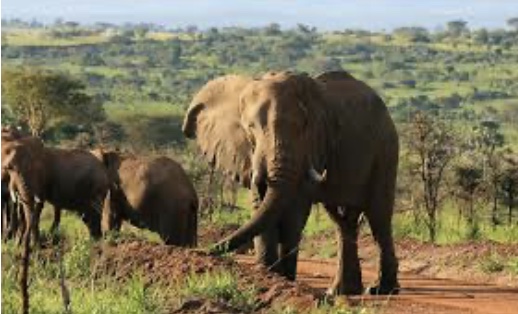
Elephants in Uganda; the Savannah and Forest Elephants can be well-observed if you travel to places like Murchison Falls National Park and Queen Elizabeth National Park.
In Ishaha you can make comparisons with the elephants which cross back and forth into Uganda and Congo from the Ntungwe River. You can notice the difference in size and colour and the forest elephants are more destructive than those in the Open Savannah grass lands.
Savanna elephants are intelligent, sociable, affectionate. They portray behaviors similar to humans such as caring for weaker individuals, adoption of orphaned calves and grieving over dead companions. Living in family groups of varying sizes and led by matriarchs, elephants traverse vast landscapes in search of food and water, paying no attention to political borders.
With a single mature individual consuming between 250 and 350 kg of vegetation and requiring 110 to 190 liters of water per day, the home ranges of these elephants can span several hundred square kilometers. As a result, elephants play an important role in the modification of ecosystems and creation of conditions suitable for the survival of some plants and animals.
They maintain grasslands by reducing tree cover and create water ponds for other wildlife as they dig for water using their trunks and tusks. They help with the dispersal and germination of tree species such as Borassus palms and Balanitis aegyptiaca trees, which are common in Africa.
Elephants can live up to 80 years. A fully grown savannah elephant in Uganda will weigh between 3500kgs to 12000kgs. Females are known to be slightly smaller than males, a baby elephant (calf) will normally weigh about 105kgs after the long gestation period of the mother which runs for 22 months.
An Elephant will use its trunk for many purposes most especially to draw water and grass for feeding but will also use the trunk to create way in the wild and some times raise the trunk up with ears wide when it sights danger. The trunk can take in up to 15-liters of water in a single draw.
The tusk of an elephant will also help it to draw water especially in clearing the weed away from the water, clear the thickets and get good grass, help push trees down to get fruits and also help in digging salt.
These tusks for a fully grown elephant, they can measure up to 3meters and can also weigh up to 90kgs. Elephants will spend around 16 hours feeding on grass, shrubs, tree branches and will consume at least 140-270 kgs in a day. They spend most of the time feeding and they will normally rest for about 2 hours.

One thought on “Elephants in Uganda”
Comments are closed.